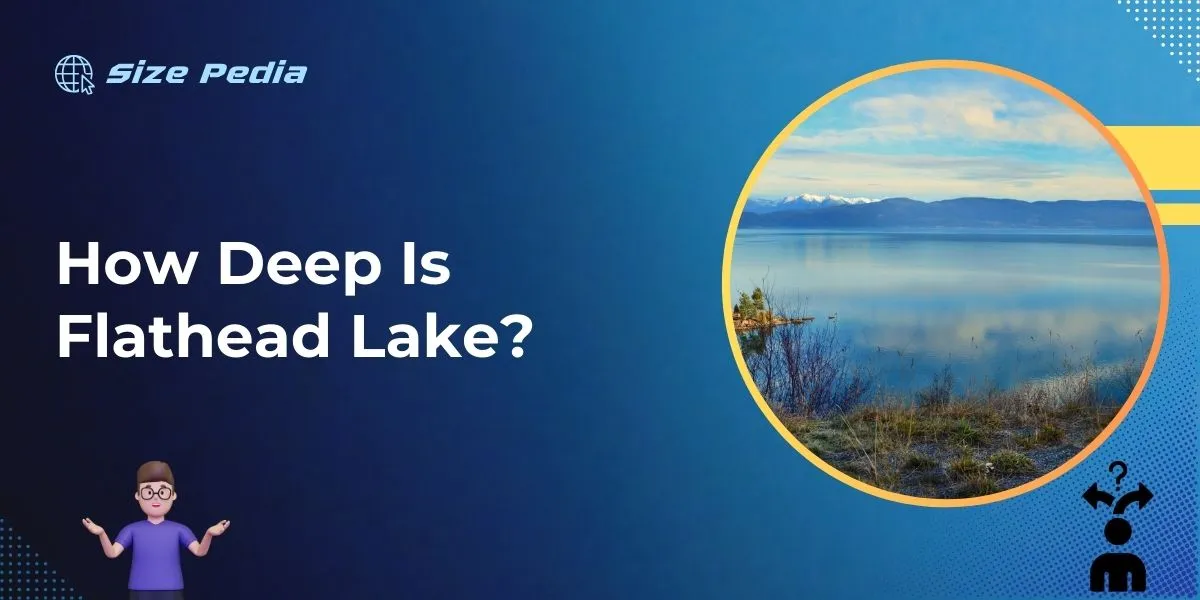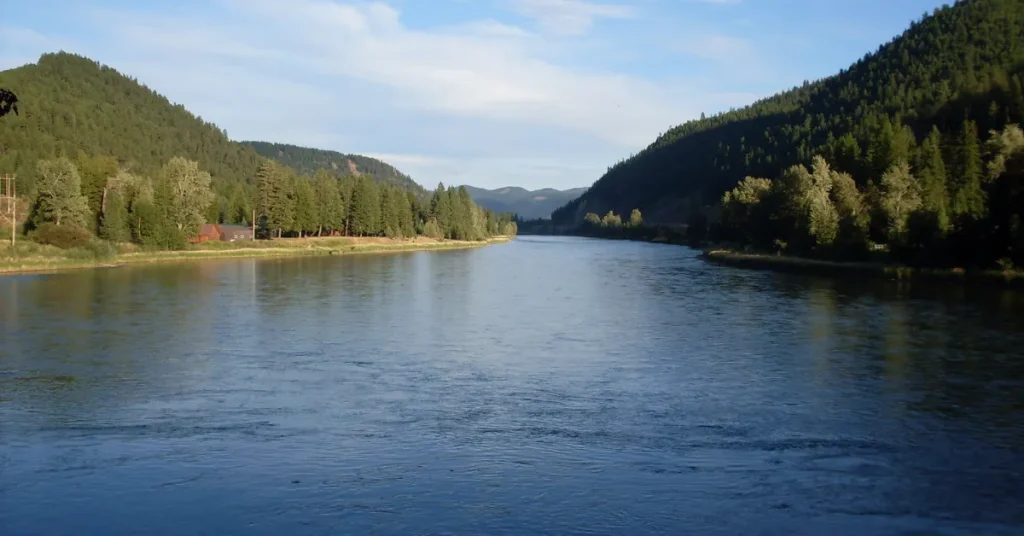Flathead Lake, located in Montana, reaches a maximum depth of 370 feet. It is one of the largest freshwater lakes in the United States.
Nestled in the Northwest region of Montana, Flathead Lake is renowned for its crystal-clear waters and scenic beauty.
This natural marvel spans over 200 square miles, offering a playground for water enthusiasts and nature lovers alike. With its abundant fish population, the lake is a premier destination for anglers.
Vacationers and locals alike flock to its shores for boating, swimming, and camping amid the breathtaking backdrop of the surrounding mountains. The lake’s sheer size and depth make it not only a hub for recreational activities but also an important ecosystem supporting diverse wildlife.

Flathead Lake Under The Surface
An expanse of crystal-clear water stretching under the Big Sky, Flathead Lake invites intrigue and wonder.
Beneath its shimmering surface, this vast body of water conceals depths that beckon the curious to explore. Join us on a journey into the heart of one of Montana’s most captivating natural wonders as we dive deep into the story of Flathead Lake Under the Surface.
The Mystique Of Montana’s Natural Treasure
Flathead Lake, veiled in the majesty of Northwestern Montana, holds secrets beneath its waves. Tales of ancient tribes, legendary monsters, and sunken treasures swirl around its deep blue waters.
As the largest natural freshwater lake west of the Mississippi in the contiguous United States, it is a focal point for myth and lore. The lake’s sheer size and depth create a sense of mystery, drawing visitors from around the globe to its picturesque shores.
Facts And Figures
Here are some remarkable facts and figures about Flathead Lake:
- Maximum Depth: At its deepest, Flathead Lake descends to about 370 feet.
- Surface Area: Spreading across roughly 200 square miles, its surface is a mirror to the sky.
- Water Volume: Holding more than 5 trillion gallons of water, its volume is staggering.
| Measure | Value |
| Length | 28 miles |
| Width | 15 miles |
| Shoreline | 160 miles |
Water Clarity: With visibility up to 30 feet, the lake’s crystal waters are a window to its aquatic life.
As we delve into the silent world under the surface, we discover an environment teeming with native fish, extraordinary habitats, and geological wonders. Flathead Lake’s depths are not just numbers but narrate a story of ecological significance and natural beauty.
Delving Into The Depths
Flathead Lake, a natural wonder, holds mysteries beneath its surface. Its depth intrigues locals and visitors alike. In this section, we dive deep to understand just how profound this lake is.
Measuring The Lake’s Profundity
To gauge the lake’s depth, scientists have used advanced technology. Sonar equipment sends sound waves to the bottom and measures their return time. This reveals the lake’s deepest points.
- Maximum depth recorded: about 370 feet
- Average depth: 164 feet
The lake varies in depth, with shallower shores and a deep central trench. These figures offer a glimpse into Flathead Lake’s vast underwater terrain.
Comparisons With Other North American Lakes
How does Flathead Lake stack up against other North American giants? Let’s compare.
| Lake | Maximum Depth |
| Flathead Lake | 370 feet |
| Great Bear Lake | 1,463 feet |
| Lake Tahoe | 1,645 feet |
| Crater Lake | 1,949 feet |
In comparison, Flathead Lake is not the deepest in North America. Yet, its crystal-clear waters and vastness still amaze everyone.
Geological Tales Of The Flathead Lake

Welcome to the secrets buried within Flathead Lake, a treasure trove of geological marvels. Let’s dive deep into the past, uncovering layers of history etched in the very bedrock of this magnificent lake.
Formation History
Flathead Lake, a testament to the forces of nature, came into existence as glaciers carved their way through the terrain during the last Ice Age.
Around 12,000 years ago, as vast ice sheets retreated, they left behind a sprawling basin that filled with meltwater, giving birth to today’s Flathead Lake.
- Glacial origins, dating back thousands of years
- Continual shaping by ice and water
- The lake’s depth reaching up to 370 feet
Sediments And Structures
Flathead Lake’s bed tells the story of time in layers of silt, gravel, and rock. These sediments, some deposited by ancient rivers, others by glaciers, narrate the geological history of the region.
| Layer Type | Composition | Age |
| Topsoil | Organic matter | Recent |
| Clay & Silt | Minerals & Water | Post-glacial |
| Bedrock | Quartzite & Argillite | Pre-glacial |
The lake’s structures range from shallow bays to steep drop-offs. These features reveal varying sediment deposition patterns, greatly influenced by the lake’s dynamic water movements and historical changes in climate.
Ecological Wonders At Various Depths
Flathead Lake, nestled in the mountains of Montana, is a marvel with its own underwater universe. Its depths harbor a rich tapestry of ecosystems.
Each layer down the water column unfolds new ecological wonders. Let’s dive into the habitats within the lake and meet some notable flora and fauna.
Habitats Within The Lake
The habitats within Flathead Lake vary greatly with depth. From its sunlit shallows to the dark depths, life thrives at every level. Here’s a glimpse:
- Littoral Zone: This is the sun-kissed shallow area. Plants grow well here. Fishes and insects call this zone home.
- Limnetic Zone: Just beyond the shallows, sunlight still reaches. Many types of fish swim here. This zone is the heart of the lake’s life.
- Profundal Zone: This is the deep, dark bottom. Sunlight fades here. But unique creatures and plants still live.
Notable Flora And Fauna
Flathead Lake’s flora and fauna are as diverse as the lake is deep. Below is a table showcasing some of the ecological stars:
| Depth Level | Notable Species |
| Littoral Zone | Bull TroutYellow Pond-Lily |
| Limnetic Zone | Arctic GraylingFreshwater Sponges |
| Profundal Zone | Deepwater SculpinBenthic Algae |
Flathead Lake’s delicate ecosystem is a true natural treasure. Within each depth, unique communities thrive, adding to the lake’s vibrancy and ecological significance.
Exploration And Research
Welcome to the depths of discovery as we delve into the exploration and research of Flathead Lake. This magnificent body of water is not only renowned for its breathtaking beauty and recreational value but also for its depth.
Understanding this natural wonder requires scientific rigor and advanced technologies.
Scientific Studies Conducted
Researchers have been studying Flathead Lake for decades. Scientific studies focus on various aspects, including water quality, aquatic life, and geology. Here are key highlights:
- Depth measurements reveal hidden underwater features.
- Water samples help us understand ecosystem health.
- Studies on native and invasive species shape conservation strategies.
The University of Montana operates the Flathead Lake Biological Station. It is a hub for ongoing research activities. Important findings from the station include:
| Year | Study Focus | Key Outcome |
| 2021 | Lakebed mapping | Identified new geological structures |
| 2020 | Water clarity | Exceptional transparency recorded |
Technologies In Use
Modern technologies afford scientists intricate views beneath the lake’s surface. The technologies employed include:
- Sonar systems map the lakebed with precision.
- Remote operated vehicles (ROVs) allow underwater exploration without diving.
- Water quality sensors continuously monitor changes in the environment.
Recent advancements have led to the deployment of:
- A high-definition 3D sonar that captures detailed imagery.
- An autonomous surface vehicle (ASV) for extended studies.
Scientists can analyze data in real time with these tools. These technologies enable groundbreaking discoveries about Flathead Lake’s depths.
The Human Factor

The Human Factor adds a vibrant layer to the story of Flathead Lake. This majestic body of water does not only boast remarkable depth but also a rich tapestry of human interaction.
Humans have influenced the lake’s waters and shorelines for centuries. Let’s explore the human touch to this natural wonder below.
Indigenous People And The Lake
Indigenous tribes lived by the lake long before others arrived. They cherished Flathead Lake for its bounty and beauty. Here’s how they connected with the lake:
- Fishing as a food source
- Spiritual ceremonies by the water
- Travel and communication via canoes
Tribes such as the Salish, Kootenai, and Pend d’Oreilles revered the lake as a community hub. It was a site for gathering, sustenance, and celebration.
Recreational Use And Its Impact
In modern times, Flathead Lake has become a popular recreational destination. Its clear waters and scenic views attract countless visitors each year. Here’s a snapshot of recreational activities:
| Activity | Impact |
| Boating | Potential for water pollution |
| Fishing | Change in fish population dynamics |
| Swimming | Beach erosion and litter |
Despite its beauty, the impact of these activities on Flathead Lake’s ecosystem is significant. Efforts to minimize human footprint and preserve the lake’s pristine nature remain crucial.
FAQs About How Deep Is Flathead Lake
What Is The Maximum Depth Of Flathead Lake?
Flathead Lake, located in northwest Montana, reaches a maximum depth of approximately 370 feet (113 meters). This depth makes it one of the deepest natural freshwater lakes in the United States.
How Does Flathead Lake’s Depth Compare To Other Lakes?
Compared to other U. S. freshwater lakes, Flathead Lake ranks as the 29th deepest. While notably deep, it is shallower than Crater Lake in Oregon but deeper than Tahoe Lake in California.
Is Flathead Lake Good For Deep-water Activities?
Yes, Flathead Lake’s significant depth provides ideal conditions for various deep-water activities, including scuba diving, sailing, and fishing. Its clear waters and underwater features attract water sports enthusiasts.
Can You Fish In Deep Parts Of Flathead Lake?
Fishing is a popular activity on Flathead Lake, and its depth allows for a diverse fish population. Anglers can seek out species like lake trout that often dwell in the lake’s deeper sections.
Conclusion
Exploring the depths of Flathead Lake has revealed its breathtaking scope. With its impressive max depth of 370 feet, it captivates visitors and researchers alike.
Remember, this lake’s dimensions offer more than just recreational opportunities—they tell a story of geological history.
Embrace the adventure of Flathead, and dive into its wonders on your next visit.
Resources:
1. https://fwp.mt.gov/stateparks/flathead-lake
